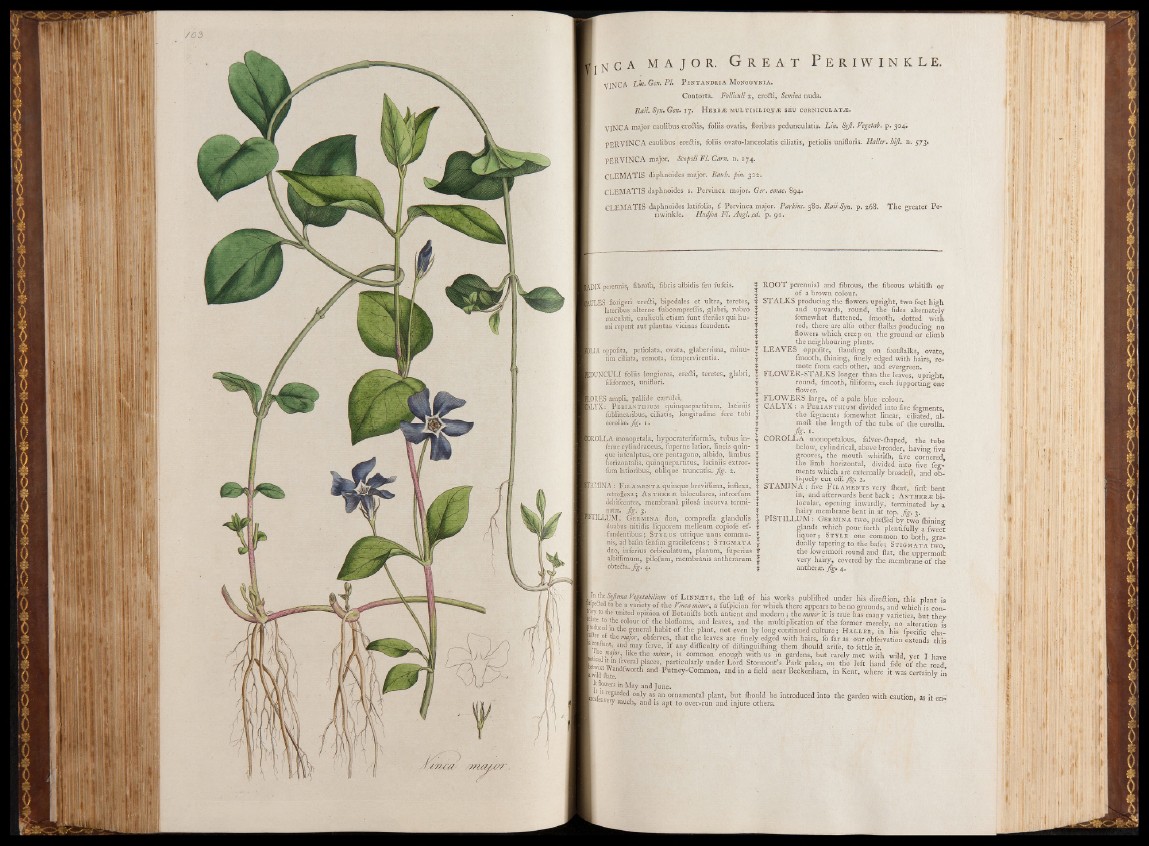
J.n ca m a j o r . G r e a t P e r i w i n k l e .
viNCA jjn, Gen. PI. P e n t a n d r i a M o n o g y n ia .
Contorta. Folliculi 2, ere£ti, Semina nuda.
Fait. Syn. Gen. 17. H e r b ® m u l t i s i l i q u ® s e u c o r n i c u l a t®.
yiNCA major caulibus eredtis, foliis ovatis, floribus peduncuiatis. Lin. Syjl. Vegetab. p. 304'.
PER VINCA -caulibus ere&is, foliis ovato-lanceolatis ciliatis, petiolis unifloris. Haller, biß. n. 573.
PERVINCA major. Scopoli FI. Cam. n. 174.
CLEMATIS daphnoides major. Bauh. pin. 302.
CLEMATIS daphnoides s. Pervinca major. Ger. emac. 894.
CLEMATIS daphnoides latifolia, f. Pervinca major. Parkins. 380. Rail Syn. p. 268. The greater Periwinkle.
FLudfon Fl. Angl. ed. p. 91.
«DIX perennis, fibrofa, fibris albidis feu fufcis. t
■ ULES florigeri ereâi, bîpedales et ultra, teretes,
lateribus alterne fobcompreflis, glabri, rubro
maculati, cauliculi etiam font ft er i les qui hu-
mi repent aut plantas vicinas fcandent.
IpiA oppofita, petiolata, ovata, glaberrima, minu-
tim ciliata, remota, fempervirentia.
jDUNCULI foliis longiores,. ere&i, teretes, glabri,
filiformes, uniflori.
LORES ampli, pallide cærulei.
®LYX: PerianthiuM quinquepartitum, laciniis
* fublinearibus, ciliatis, longitudine fere tubi
corollæ. Jig. 1.
;ROLLA monopetala, hypocrateriformis, tubus in-
ferne cylindraceus, foperne latior, lineis quin-
que infculptus, ore pentagono, albido, limbus
horizontalis, quinquepartitus, laciniis extror-
fum latioribus, oblique truncatis. Jig. 2.
JAL1INA : Fjlamenta quinque breviflima, inflexa,
retroflexa; A nther® biloculares, introrfom
dehifcentes, membranâ pilosâ incurva termi-
natæi jig. 3.
JSTILLUM : Germina duo, compreffa glandulis
duabus nitidis liquorem melleum copiofe ef-
fundentibus; Stylus utrique ùnus communis,
ad bafin fenfim gracilefcens ; Stigmata
duo, inferius orbiculatum, planum, foperius
albiflimum, pilofum, membranis antherarum
obtefta. jig. 4.
ROOT perennial and fibrous, the fibrous whitifh or
of a brown colour.
STALKS producing the flowers upright, two feet high
and upwards, round, the fides alternately
fomewhat flattened, fmooth, dotted with
red, there are alfo other ftalks producing no
flowers which creep on the ground or climb
the neighbouring plants.
LEAVES oppofite, ftanding on footftalks, ovate,
fmooth, fhining, finely edged with hairs, remote
from each other, and evergreen.
FLOWER-STALKS longer than the leaves, upright,
round, fmooth, filiform, each fupporting one
flower.
FLOWERS large, of a pale blue colour.
CALYX : a P e r i a n t h iu m div ided in to fiv e fe gm ents ,
th e fegm ents fom ew h a t lin ea r, c ilia ted , al-
mo ft th e le n g th o f th e tube o f th e co ro lla .
fg - 1*
COROLLA monopetalous, falver-fhaped, the tube
below, cylindrical, above broader, having five
grooves, the mouth whitifh, five cornered,
the limb horizontal, divided into five fegments
which are externally broadeft, and obliquely
cut off. jig. 2.
; ST AM IN A : five F ilaments very fhort, firft bent
in, and afterwards bent back ; A nther.® bilocular,
opening inwardly, terminated by a
hairy membrane bent in at top. jig. 3.
i PISTILLUM : Germina two, prefled by two fhining
glands which pour forth plentifully a fweet
• liquor j St y le one common to both, gradually
tapering to the bafe; Stigmata two,
the lowermoft round and flat, the uppermoft
very hairy, covered by the membrane of the
f antheras. fig. 4.
_n the Syjlema Vegeiabilium' of _Linn®us, the laft of his works publifhed under his diredion, this, plant is
glpedted to be a variety of the Vinca minor, a fufpicion for which there appears to be no grounds, and which is con-
|ry to the united opinion of Botanifts both antient and modern ; the minor it is true has many varieties, but they
r.te to tbe colour of the blofloms, and leaves, and the multiplication of the former merely, no alteration is
|oduced in the general habit of the plant, not even by long continued culture; H a l l e r , in his fpecific chapter
of the major, obferves, that the leaves are finely edged with hairs, fo far as our obfervation extends this
iTOnItant, and may ferve, if any difficulty of diftinguifhing them fhould arife, to fettle it.
he Wa/or, like the minor, is common enough with us in gardens, but rarely met with wild, yet I have
» iced it m federal places, particularly under Lord Stormont’s Park pales, on the left hand fide of the road
fwild^^Wandfworth and Putney-Common, and in a field near Beckenham, in Kent, where it was certainly in
lit flowers in May and June.
ieafesY663^ ! 011^ as. aa ornamental plant, but fhould be introduced into the garden with caution, as it en-
| ery much, and is apt to over-run and injure others.